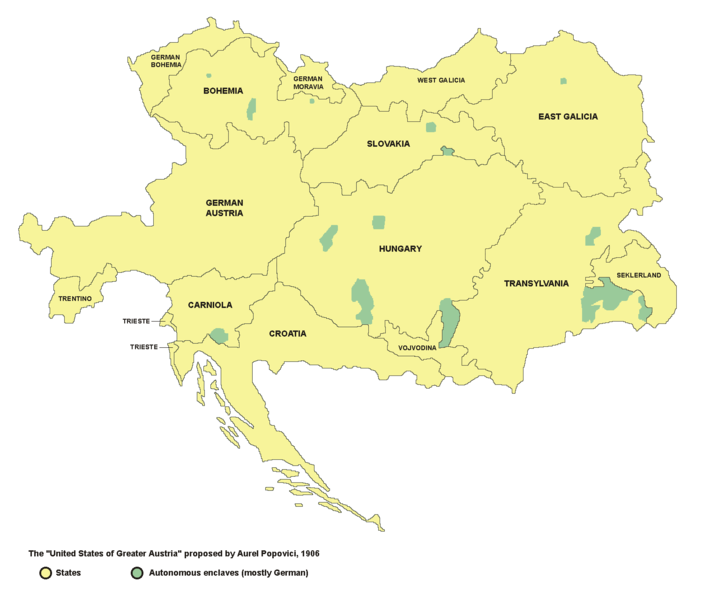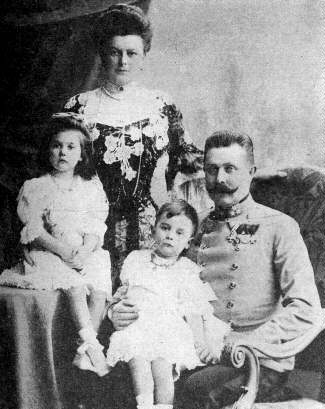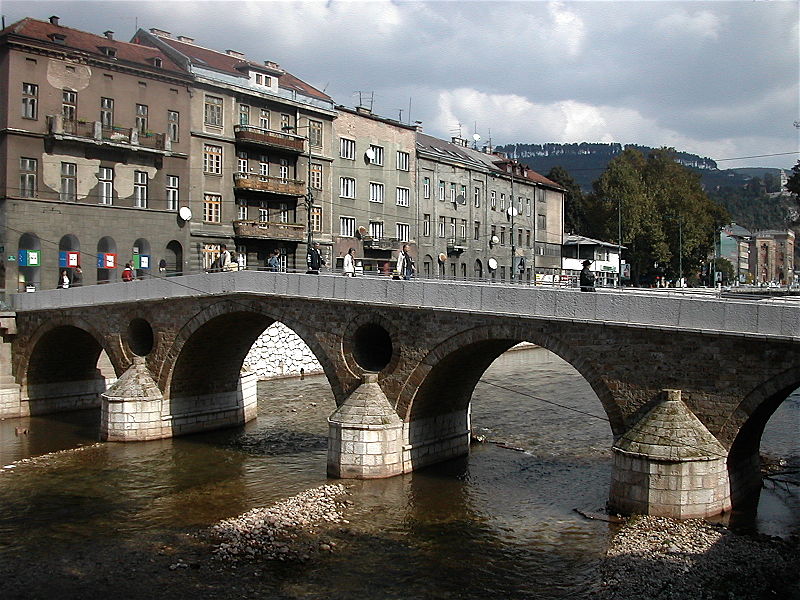<Back to Index>
- Physicist Christopher Polhem, 1661
- Painter Paul Klee, 1879
- Archduke of Austria-Este Franz Ferdinand, 1863
PAGE SPONSOR


Franz Ferdinand (18 December 1863 – 28 June 1914) was an Archduke of Austria-Este, Austro - Hungarian, and Royal Prince of Hungary and of Bohemia, and from 1889 until his death, heir presumptive to the Austro - Hungarian throne. His assassination in Sarajevo precipitated Austria - Hungary's declaration of war against Serbia. This caused Germany and Austria - Hungary, and countries allied with Serbia (the Triple Alliance Powers) to declare war on each other, starting World War I.
He was born in Graz, Austria, the oldest son of Archduke Karl Ludwig of Austria (younger brother of Franz Joseph and Maximilian) and of his second wife, Princess Maria Annunciata of Bourbon - Two Sicilies. When he was only twelve years old, his cousin Duke Francis V of Modena died, naming Franz Ferdinand his heir on condition that he add the name Este to his own. Franz Ferdinand thus became one of the wealthiest men in Austria.
In
1889, Franz Ferdinand's life changed dramatically. His cousin Crown Prince
Rudolf committed suicide at his hunting lodge in Mayerling, leaving Franz Ferdinand's
father, Archduke Karl Ludwig, as first in line to the
throne. However, his father renounced his succession rights a few days
after the Crown Prince's death. Henceforth,
Franz
Ferdinand was groomed to succeed. Despite this burden, he did
manage to find time for travel and personal pursuits - for example, the
time he spent hunting kangaroos and emus in Australia in 1893,
and the return trip to Austria sailing across the Pacific on the RMS Empress of China from Yokohama to Vancouver.
In 1895 Franz Ferdinand met Countess Sophie Chotek at a ball in Prague. To be an eligible marriage partner for a member of the Imperial House of Habsburg, one had to be a member of one of the reigning or formerly reigning dynasties of Europe. The Choteks were not one of these families, although they did include among their ancestors, in the female line, princes of Baden, Hohenzollern - Hechingen, and Liechtenstein. One of Sophie's direct ancestors was Albert IV, Count of Habsburg; he was descended from Elisabeth of Habsburg, a sister of King Rudolph I of Germany. Franz Ferdinand was a descendant of King Rudolph I. Sophie was a lady-in-waiting to Archduchess Isabella, wife of Archduke Friedrich, Duke of Teschen. Franz Ferdinand began to visit Archduke Friedrich's villa in Pressburg (now Bratislava). Sophie wrote to Franz Ferdinand during his convalescence from tuberculosis on the island of Lošinj in the Adriatic. They kept their relationship a secret for more than two years. Deeply in love, Franz Ferdinand refused to consider marrying anyone else. Pope Leo XIII, Tsar Nicholas II of Russia, and the German Emperor Wilhelm II all made representations on his behalf to Emperor Franz Joseph of Austria, arguing that the disagreement between Franz Joseph and Franz Ferdinand was undermining the stability of the monarchy. Finally, in 1899, Emperor Franz Joseph agreed to permit Franz Ferdinand to marry Sophie, on condition that the marriage would be morganatic and that their descendants would not have succession rights to the throne. Sophie would not share her husband's rank, title, precedence, or privileges; as such, she would not normally appear in public beside him. She would not be allowed to ride in the royal carriage or sit in the royal box.
The wedding took place on 1 July 1900, at Reichstadt (now Zákupy) in Bohemia; Franz Joseph did not attend the affair, nor did any archduke including Franz Ferdinand's brothers. The only members of the imperial family who were present were Franz Ferdinand's stepmother, Princess Maria Theresa of Braganza, and her two daughters. Upon the marriage, Sophie was given the title "Princess of Hohenberg" (Fürstin von Hohenberg) with the style "Her Serene Highness" (Ihre Durchlaucht). In 1909, she was given the more senior title "Duchess of Hohenberg" (Herzogin von Hohenberg) with the style "Her Highness" (Ihre Hoheit). This raised her status considerably, but she still yielded precedence at court to all the archduchesses. Whenever a function required the couple to gather with the other members of royalty, Sophie was forced to stand far down the line of importance, separated from her husband.
The German historian Michael Freund described Franz Ferdinand as "a man of uninspired energy, dark in appearance and emotion, who radiated an aura of strangeness and cast a shadow of violence and recklessness ... a true personality amidst the amiable inanity that characterized Austrian society at this time." As his sometime admirer Karl Kraus put it, "he was not one who would greet you ... he felt no compulsion to reach out for the unexplored region which the Viennese call their heart." His relations with Emperor Franz Joseph were tense; the emperor's personal servant recalled in his memoirs that "thunder and lightning always raged when they had their discussions." The commentaries and orders which the heir to the throne wrote as margin notes to the documents of the Imperial central commission for architectural conservation (where he was Protector) reveal what can be described as "choleric conservativism."
Franz Ferdinand had a fondness for trophy
hunting that
was excessive even by the standards of European nobility of this time.
In his diaries he kept track of an estimated 300,000 game kills, 5,000
of which were deer. A small fraction of the trophies were
on exhibit at his Bohemian castle at Konopiště which he also stuffed with various
antiquities, his other great collection passion.
Politically, Franz Ferdinand was a proponent of granting greater autonomy to all ethnic groups in the Empire and of addressing their grievances, especially the Czechs in Bohemia and the Yugoslavic peoples in Croatia and Bosnia, who had been left out of the Austro - Hungarian compromise of 1867. He also advocated a careful approach towards Serbia - repeatedly locking horns with Franz Conrad von Hötzendorf, Vienna's hard line Chief of the General Staff, warning that harsh treatment of Serbia would bring Austria - Hungary into open conflict with Russia, to the ruin of both Empires.
Franz Ferdinand was a prominent and
influential supporter of the Austro
- Hungarian Navy in
a time when sea power was not a priority in Austrian foreign policy and
the Navy was relatively little known and supported by the public. After
his assassination in 1914, the Navy honoured Franz Ferdinand and his
wife with a lying
in state aboard the SMS
Viribus Unitis.
On Sunday, 28 June 1914, at approximately 1:15 pm, Franz Ferdinand and his wife were killed in Sarajevo, the capital of the Austro - Hungarian province of Bosnia and Herzegovina, by Gavrilo Princip, 19 at the time, a member of Young Bosnia and one of a group of assassins organized by the Black Hand. The event led to a chain of events that eventually triggered World War I. The couple had previously been attacked when a grenade was thrown at their car. Ferdinand deflected the grenade and it detonated far behind them. He is known to have shouted in anger to local officials, So you welcome your guests with bombs. The royal couple insisted on seeing all those injured at the hospital. After travelling there, Franz and Sophie decided to go to the palace, but their driver took a wrong turn onto a side street, where Princip spotted them. As the car was backing up, Princip approached and shot Sophie in the abdomen and Franz Ferdinand in the jugular. He was still alive when witnesses arrived to render aid. His dying words to Sophie were, 'Don't die darling, live for our children.' Princip had used the Browning .32 ACP cartridge, a relatively low power round, and a pocket sized FN model 1910 pistol. The archduke's aides attempted to undo his coat but realized they needed scissors to cut it open. It was too late; he died within minutes. Sophie also died en route to the hospital.
A detailed account of the shooting can be found in Sarajevo by Joachim Remak:
One bullet pierced Franz Ferdinand's neck while the other pierced Sophie's abdomen. ... As the car was reversing (to go back to the Governor's residence because the entourage thought the Imperial couple were unhurt) a thin streak of blood shot from the Archduke's mouth onto Count Harrach's right cheek (he was standing on the car's running board). Harrach drew out a handkerchief to still the gushing blood. The Duchess, seeing this, called: "For Heaven's sake! What happened to you?" and sank from her seat, her face falling between her husband's knees.
Harrach and Potoriek ... thought she had fainted ... only her husband seemed to have an instinct for what was happening. Turning to his wife despite the bullet in his neck, Franz Ferdinand pleaded: "Sopherl! Sopherl! Sterbe nicht! Bleibe am Leben für unsere Kinder! - Sophie dear! Don't die! Stay alive for our children!". Having said this, he seemed to sag down himself. His plumed hat ... fell off; many of its green feathers were found all over the car floor. Count Harrach seized the Archduke by the uniform collar to hold him up. He asked "Leiden Eure Kaiserliche Hoheit sehr? - Is Your Imperial Highness suffering very badly?" "Es ist nichts - It is nothing" said the Archduke in a weak but audible voice. He seemed to be losing consciousness during his last few minutes, but, his voice growing steadily weaker, he repeated the phrase perhaps six or seven times more.
A rattle began to issue from his throat, which subsided as the car drew in front of the Konak bersibin (Town Hall). Despite several doctors' efforts, the Archduke died shortly after being carried into the building while his beloved wife was almost certainly dead from internal bleeding before the motorcade reached the Konak.
The assassinations, along with the arms race, nationalism, imperialism, militarism, and the alliance system all contributed to the Origins of World War I, which began less than two months after Franz Ferdinand's death, with Austria - Hungary's declaration of war against Serbia.
Franz Ferdinand is interred with his wife
Sophie in Artstetten
Castle, Austria.
Archduke Franz Ferdinand and his Castle
of Artstetten were selected as a main motif for the
Austrian 10 euro. The
Castle of Artstetten commemorative coin,
minted on 13 October 2004. The reverse shows the entrance to the crypt
of the Hohenberg family. There are two portraits to the left, showing
Archduke Franz Ferdinand and his wife Sophie, Duchess of Hohenberg.



